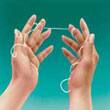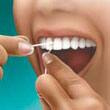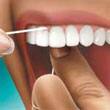What is the Right Way to Floss?
Proper flossing removes plaque and food particles in places where a toothbrush cannot easily reach - under the gumline and between your teeth. Because plaque build-up can lead to tooth decay and gum disease, daily flossing is highly recommended.
To receive maximum benefits from flossing, use the following technique:
- Starting with about 18 inches of floss, wind most of the floss around each middle finger, leaving an inch or two of floss to work with
- Holding the floss tautly between your thumbs and index fingers, slide it gently past the tight contact point between the teeth
- Gently curve the floss around the base of each tooth, making sure you go beneath the gumline. Never snap or force the floss, as this may cut or bruise delicate gum tissue
- Use clean sections of floss as you move from tooth to tooth
- To remove the floss, use the same back-and-forth motion to bring the floss up and away from the teeth
What Type of Floss Should I Use?
There are two types of floss from which to choose:
- Nylon (or multifilament) floss
- PTFE (monofilament) floss
Nylon floss is available waxed and unwaxed, and in a variety of flavors. Because this type of floss is composed of many strands of nylon, it may sometimes tear or shred, especially between teeth with tight contact points. While more expensive, single filament (PTFE) floss slides easily between teeth, even those with tight spaces between teeth, and is virtually shred-resistant. When used properly, both types of floss are excellent at removing plaque and debris.
 |
 |
 |
Use about 18" of floss, leaving an inch or two to work with. |
Gently follow the curves of your teeth. |
Be sure to clean beneath the gumline, but avoid snapping the floss on the gums. |
11/15/2010







